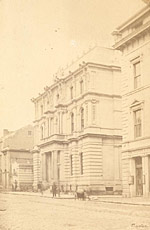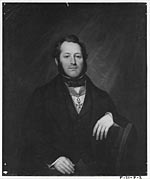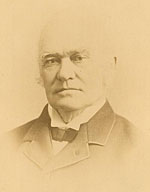

Profile of elected representatives
Most elected representatives came from the business community, but there were very few from the richer upper classes. Wealth represented the first political resource. City council was much like a select club reserved for members of the business elite. Elected officials established strong ties with the provincial political establishment, and the federal establishment as of 1867. Some held a plurality of offices, either as councillor or mayor, as well as legislative counsel or member of parliament.
Until 1882, anglophones dominated city council and represented an average of 60% of elected representatives. The urban population was mostly anglophone from 1831 to 1865.
Charles Wilson
The first elected mayor of Montréal was a good example of that type of politician. Born in Coteau-du-lac in 1808, Charles Wilson was a prosperous hardware dealer. He was on the board of directors of the Scottish Provincial Insurance Company, and was elected councillor for the Centre District in 1847. Appointed mayor for the first time in 1851, he was elected both in 1852 and in 1853. Wilson served as legislative counsel in 1852 and sat in the Senate from 1867 to 1877.
John Caldwell Abbott
One of the mayors who clearly stood out was John Caldwell Abbott. He also became the third prime minister of Canada. Born in 1821 in the district of Argenteuil, Abbott worked several years for a maritime company before taking up law. He practised during the 1840s and carved out a distinguished career in politics. He became active in politics in 1859, representing the district of Argenteuil in the National Assembly. At the time of Confederation, he was elected to the House of Commons.
John Caldwell Abbott became the nineteenth mayor of Montréal in 1887 and was re-elected the following year. In 1890, he sat in the Senate. He became prime minister of Canada in 1891 after the death of Sir John A. McDonald, and held that office until November 1892. He died 11 months later.
Doubtless in a show of pomp and circumstance, mayors donned their ceremonial dress on official occasions. That old English practice was introduced in Montréal in 1851 when city council decided to provide the first magistrate of the city with a sumptuous chain. The coat of arms of Montréal figured prominently in the centre of the gold chain. On October 2, 1851, that chain was passed on to mayor Wilson at a ceremony presided over by lord Elgin, governor general of Canada. The chain is now worn by each new mayor at the swearing in ceremony.
To celebrate the visit by the Prince of Wales in 1860, the mayor donned a scarlet toga garnered with marten from the Hudson Bay, and valued at $404.25.
The toga and chain were worn on formal occasions up to the beginning of the twentieth century.















